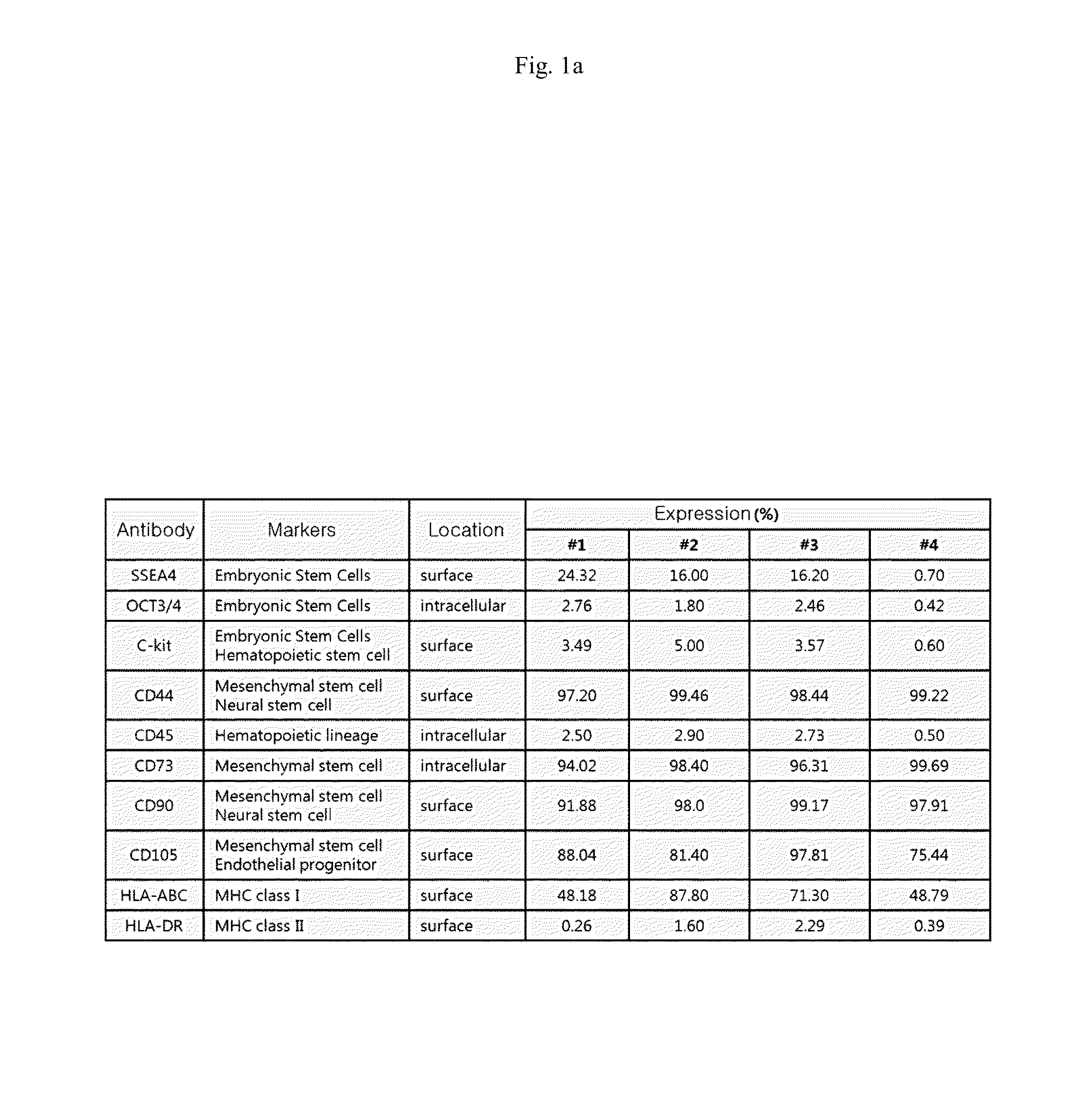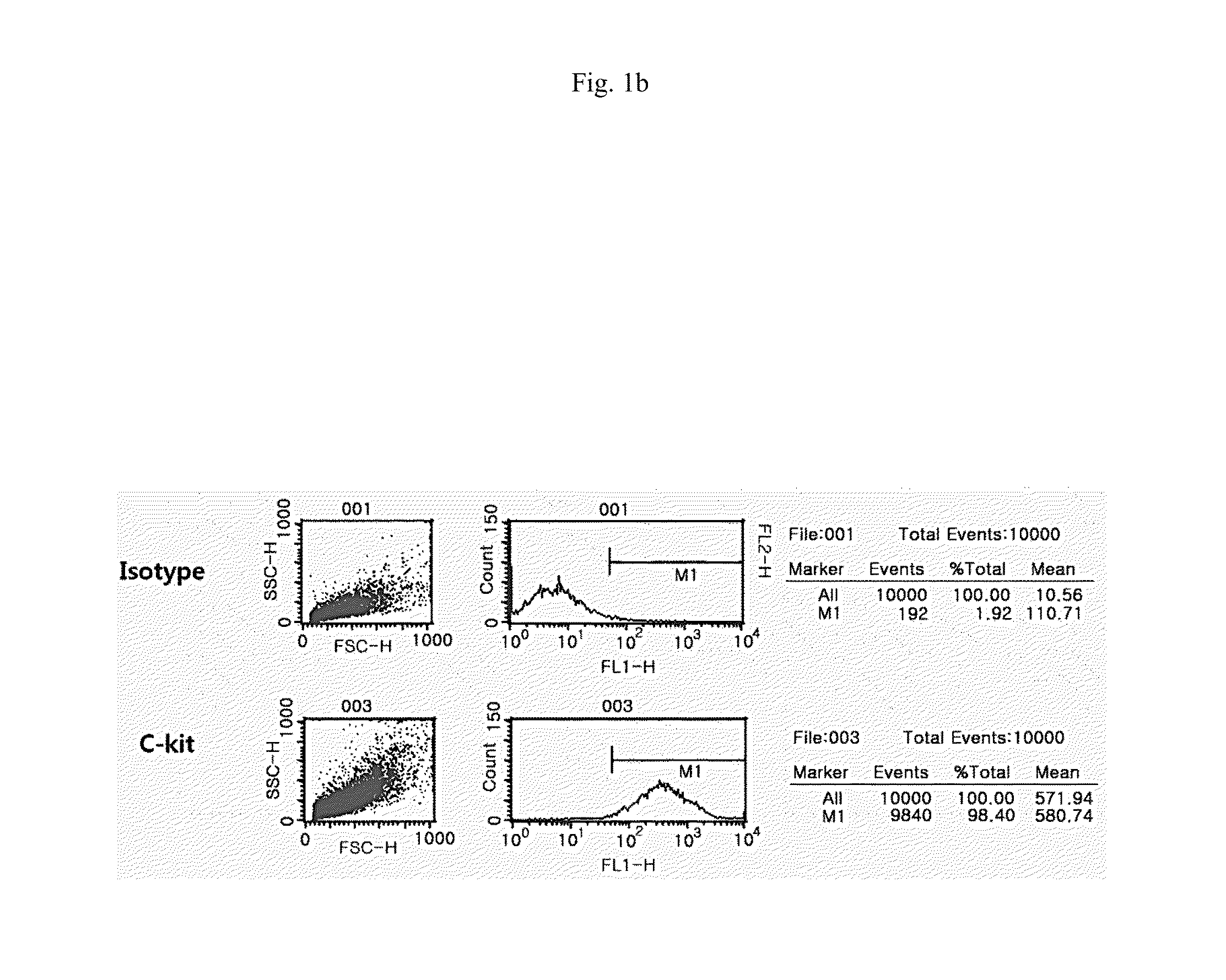Agent for treating urinary incontinence including stem cells derived from amniotic fluid
a technology of amniotic fluid and stem cells, which is applied in the field of amniotic fluidderived stem cells in cellular therapeutic agents, can solve the problems of difficult culture, weakening of pelvic floor muscles, and difficult to maintain isolated stem cells in vitro, so as to effectively control urinary incontinence, restore muscle function, and achieve muscle function
- Summary
- Abstract
- Description
- Claims
- Application Information
AI Technical Summary
Benefits of technology
Problems solved by technology
Method used
Image
Examples
example 1
Characteristics of Human Amniotic Fluid Cells and Isolation of AFSCs
[0033]The present study and the use of human amniotic fluid was approved by the Ethics Committee of the Medical School of Kyungpook National University.
[0034]Amniotic fluids were obtained from women undergoing routine amniocentesis at a gestational age of 15 to 19 weeks after informed consent. Amniotic fluids containing cells were cultured on cover glass in Amino MAXTMII (Gibco-Invitrogen, Grand Island, N.Y.) for at least two week. Cells were harvested with trypsin / EDTA solution and cultured with Chang Medium (α-MEM, 15% ES-FBS, 1% glutamine, and 1% penicillin / streptomycin, Gibco), 18% Chang B, and 2% Chang C (Irvine Scientific, Irvine, Calif.) at 37° C. under 5% CO2 in petri dishes. The cells were maintained at 70-80% confluence without any feeder layer.
[0035]The cultured amniotic fluid cells (passage 3) were analyzed by fluorescence activated cell sorter (FACS, BD Biosciences, San Jose, Calif.) using various surfa...
example 2
Differentiation of hAFSCs into Myocytes in Vivo
[0036]Three different types of myogenic media were used to differentiate hAFSCs into myocyte-like cells: (i) myogenic medium (0.5% chick embryo extract, 10% horse serum, 1% penicillin / streptomycin, DMEM low glucose, all from Gibco-Invitrogen) treated with 3 mM 5-aza-20-deoxycytidine (5-azaC; Sigma-Aldrich, St. Louis, Mo.); (ii) myogenic medium treated with TGF-β (5 ng / ml, Peprotech, Rocky Hill, N.J.); and (iii) conditioned medium (CM) (obtained from human skeletal muscle cell culture medium).
[0037]hAFSCs were seeded in culture medium at a density of 3,000 cells / cm2 and cultured with Chang medium for 24 hours. Then, the medium was replaced with myogenic medium. After hour culture, the myogenic medium was replaced with myocyte culture medium. Cells were grown up to 14 days for analysis. Under 5-azaC condition, Matrigel pre-coated dishes (BD Biosciences) were used.
[0038]Cell viability at 14 days was measured using a CCK-8 assay kit (Dojind...
example 3
Incapacitation of Urethral Sphincter and Injection of hAFSCs
[0041]Mice were treated according to National Institutes of Health Animal Care Guidelines, which were approved by the Animal Ethics Committee of the Medical School of Kyungpook National University. All experiments were performed using 4-week-old female ICR mice (2025 mg). Before the surgical injury to the urethral sphincter, the abdominal leak point pressure (LPP) and closing pressure (CP) were measured. Immediately, anesthesia was induced by intramuscular injection of Zoletil (30 mg / kg, virbac animal health, France) and Rumpun (10 mg / kg, Bayer, Korea). A lower midline abdominal incision was performed and the pudendal nerves on both sides were found. The bilateral pudendal nerves were transected with surgical scissors under a microscope.
[0042]hAFSCs (1×106) were injected using a 26G Hamilton microsyringe (Hamilton Company, Reno, Nev.) with microscopic guidance. Three experimental groups were established: a control group (Ct...
PUM
 Login to View More
Login to View More Abstract
Description
Claims
Application Information
 Login to View More
Login to View More - R&D
- Intellectual Property
- Life Sciences
- Materials
- Tech Scout
- Unparalleled Data Quality
- Higher Quality Content
- 60% Fewer Hallucinations
Browse by: Latest US Patents, China's latest patents, Technical Efficacy Thesaurus, Application Domain, Technology Topic, Popular Technical Reports.
© 2025 PatSnap. All rights reserved.Legal|Privacy policy|Modern Slavery Act Transparency Statement|Sitemap|About US| Contact US: help@patsnap.com



